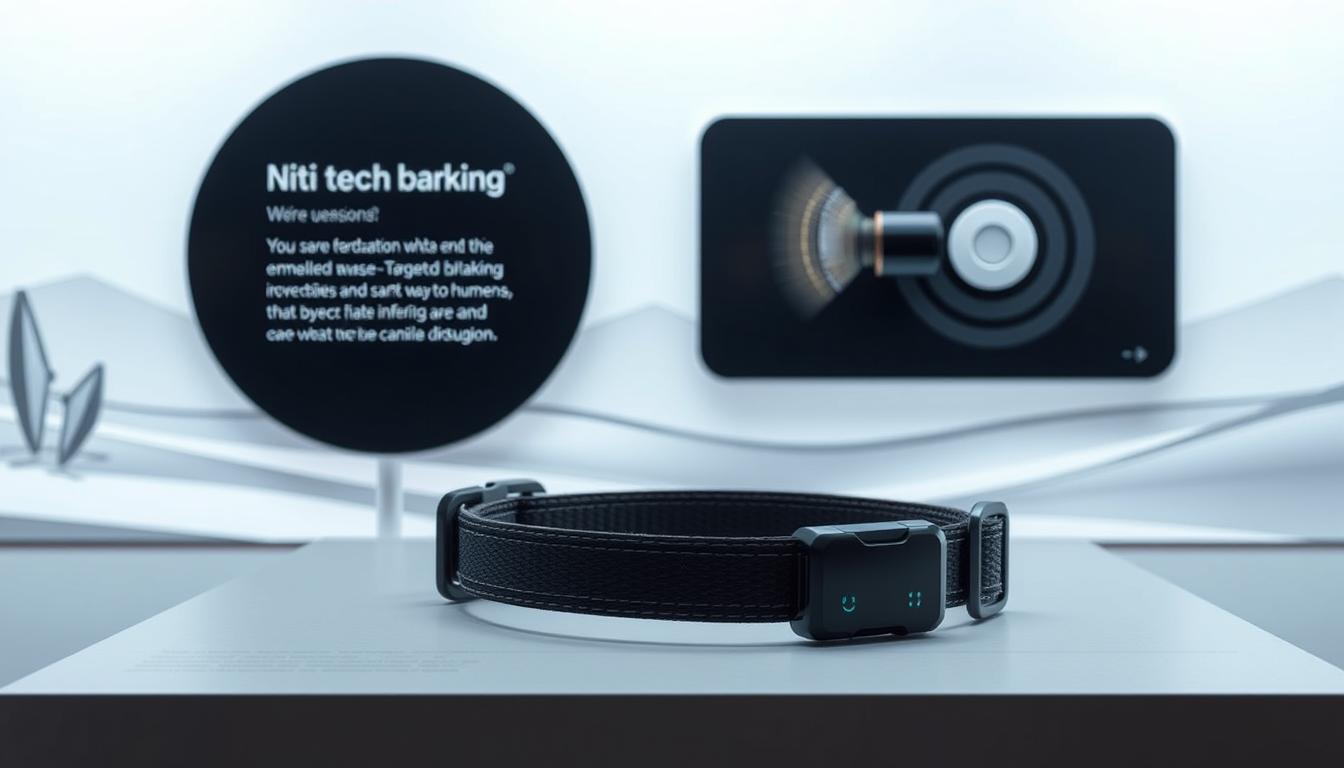Excessive dog barking can be a big problem for dog owners. It often shows there’s something wrong that needs fixing. Dog training is key to handling this issue, but sometimes, extra tools are needed.
Bark collars and anti-bark devices are common solutions. They aim to stop barking, but how well they work depends on the dog and the reasons for barking.
This article will look at the different kinds of bark collars and other ways to deal with excessive dog barking. We want to help dog owners make the best choices for their pets.
Understanding Excessive Dog Barking
It’s important to know why dogs bark too much to solve the problem.
Dogs bark for many reasons, like excitement, happiness, or fear. Finding out what makes them bark is crucial. Knowing the cause helps owners fix the problem.

There are two main reasons for excessive barking: emotional and environmental. Emotional reasons include anxiety and excitement. Environmental reasons include noises and other animals.
| Cause | Description | Potential Solution |
|---|---|---|
| Boredom/ Lack of Stimulation | Dogs bark because they’re not getting enough to do. | Give them more exercise and play, and puzzle toys. |
| Anxiety/Stress | Barking can be caused by anxiety or stress, like when they’re left alone. | Try training, desensitization, and calming aids. |
| Alerting/Protective Instinct | Dogs bark to warn owners of dangers or to protect their space. | Teach them to bark less when alerting, and manage what they see and hear. |
Understanding why dogs bark too much and using the right solutions can help. It’s about fixing the cause and making sure the dog is happy and safe.
Types of Bark Collars Available Today
Bark collars come in many types, each with its own way to stop barking. With so many bark collar options out there, finding the right one for your dog is easier.
The citronella bark collar is a common choice. It sprays a scent that dogs find unpleasant when they bark. Ultrasonic bark collars also work well. They make a sound dogs don’t like, but humans can’t hear.

Vibration bark collars are another favorite. They vibrate when the dog barks, which stops the barking. Static or shock bark collars give a mild shock when the dog barks. But, some people worry about how comfortable this is for dogs.
| Type of Bark Collar | Mechanism | Advantages | Disadvantages |
|---|---|---|---|
| Citronella | Sprays citronella scent | Humane, effective | Requires refills |
| Ultrasonic | Emits high-frequency sound | Undetectable to humans | Some dogs may not respond |
| Vibration | Vibrates upon barking | Humane, adjustable | May not be effective for all dogs |
| Static/Shock | Delivers electric stimulus | Can be effective | Potential for discomfort |
Knowing about the different types of bark collars helps you pick the best anti-bark device. Each collar has its good and bad points. What works best depends on your dog and how it barks.
How Bark Collars Work: Mechanisms and Technologies
Bark collars use advanced tech to spot barking and fix it. They aim to stop dogs from barking too much. They do this with different methods and tech.
The main job of a bark collar is to catch barking and act to stop it. The tech used is key to how well they work. They have sound, vibration, and movement sensors to know when a dog is barking.
Detection Technology
The tech in bark collars is made to spot barking right. Some use one sensor, others use more to avoid mistakes. For example, some collars use sound and vibration to make sure it’s barking.
| Detection Method | Description | Effectiveness |
|---|---|---|
| Sound Sensors | Detect the sound of barking | High |
| Vibration Sensors | Detect the vibration of the dog’s vocal cords | Medium |
| Movement Sensors | Detect the movement associated with barking | Low |
To learn more about bark collars and shock collars, check out this article.

Knowing how bark collars work helps dog owners choose wisely. They use tech to detect barking and correct it. This makes them a useful tool for controlling too much barking.
Effectiveness of Citronella Bark Collars
Citronella bark collars are becoming popular for controlling dog barking. They release a citrus-scented spray when a dog barks. This spray helps stop the barking.
The collars work by startling the dog with a harmless spray. This method is considered humane and safe. It doesn’t hurt the dog physically.
Research and user feedback show mixed results. Some dogs really respond to the spray and bark less. But, others might get used to it or not care.
| Advantages | Disadvantages |
|---|---|
| Humane and safe | May not be effective for all dogs |
| Non-invasive | Some dogs may become desensitized |
| Easy to use | Requires consistent training |
To get the most out of citronella bark collars, use them with training and positive reinforcement. This helps fix the barking problem at its source.

In summary, citronella bark collars can be a good choice for controlling dog barking. But, how well they work depends on the dog’s personality and how it reacts to the spray.
Effectiveness of Ultrasonic Bark Collars
Ultrasonic bark collars are getting more popular. But do they really work? These collars send out a high-pitched sound that dogs find unpleasant but humans can’t hear. They aim to stop dogs from barking.
How well these collars work depends on the dog. Some dogs really don’t like the sound and stop barking right away. But others might not react as strongly.
Key Factors Influencing Effectiveness:
- Dog’s sensitivity to ultrasonic sound
- Proper fitting of the collar
- Consistency in training
Different ultrasonic bark collars have different success rates. Here’s a table showing how well some models work:
| Model | Success Rate | User Reviews |
|---|---|---|
| Model A | 70% | Positive |
| Model B | 50% | Mixed |
| Model C | 80% | Very Positive |
In summary, ultrasonic bark collars can be a good tool for training dogs. But, their success depends on several things. These include how sensitive the dog is and how well the training is done.
Effectiveness of Vibration Bark Collars
Vibration bark collars are getting more attention from dog owners. They send a gentle vibration to dogs when they bark. This aims to stop the barking without hurting or upsetting them.
Vibration bark collars work on a simple principle: they use sensors to detect barking. Then, they send a vibration to get the dog’s attention. This method is kind and good for dogs that are easily upset by other collars.
| Type of Collar | Method of Deterrence | Suitability for Sensitive Dogs |
|---|---|---|
| Vibration | Vibration | High |
| Citronella | Spray | Medium |
| Ultrasonic | High-frequency sound | Low |
How well vibration bark collars work can depend on the dog. But, many owners say their dogs bark less after using these collars.
In short, vibration bark collars are a kind and effective way to stop dogs from barking too much. They are great for dogs that are easily scared or upset by other collars.
Effectiveness of Static/Shock Bark Collars
For dog owners dealing with constant barking, static/shock bark collars might be a solution. These collars give a mild electric shock when a dog barks. They aim to stop the barking.
These collars work by giving a harmless but unpleasant shock to the dog when it barks. The success of these collars depends on fitting them right and knowing the dog’s sensitivity.
Some dog owners see a big drop in barking with these collars. They say it’s because the dog gets immediate feedback. But, worries about harm and stress from the shock are common. It’s important to think about these points and look at other options before using a static/shock collar.
| Features | Static/Shock Collars | Citronella Collars | Ultrasonic Collars |
|---|---|---|---|
| Stimulus Type | Electric Shock | Citronella Spray | Ultrasonic Sound |
| Effectiveness | High | Moderate | Variable |
| Potential Drawbacks | Stress, Potential Harm | Startle Response | Auditory Sensitivity |
For more details on bark collars, check out this resource. It gives a full look at different bark collar types and how well they work.
Comparing Effectiveness Of Different Bark Collars And Alternatives
Excessive barking is a big problem for dog owners. It’s important to know how different bark collars and other solutions work. Each bark collar has its own way of stopping barking.
Citronella bark collars use a burst of citronella spray to stop barking. They work well for dogs that don’t like the smell or taste of citronella.
Ultrasonic bark collars make a high-pitched sound dogs don’t like but humans can’t hear. How well they work depends on the dog’s sensitivity to sound.
Vibration bark collars use a vibration to distract dogs from barking. They’re good for dogs that don’t respond to sound or spray.
Static/shock bark collars give a mild electric shock to stop barking. But, some people worry about their impact on dogs’ welfare.
There are also alternative methods like training and making the dog’s environment more interesting. Training can help if the barking is caused by anxiety or boredom. Changing the dog’s environment can also help reduce barking.
Choosing the right bark collar or alternative depends on the dog. What works for one dog might not work for another. So, finding the best solution needs a personalized approach.
In summary, bark collars have different levels of success. But, don’t forget about other methods. Using the right bark collar and other strategies together can be the best way to stop excessive barking.
Safety and Ethical Considerations
When looking at bark collars, it’s key to think about their safety and ethics. Some collars, like those with static shocks, worry many dog owners and animal groups. They see these collars as risky and not right.
Safety Concerns: The main worry with bark collars is hurting dogs. Static/shock collars can be painful and make dogs anxious or scared. It’s important to think about the dangers of each collar type.
Ethical Considerations: Using bark collars, like those that hurt, is a big debate. Many say these devices are cruel. They punish the barking, not the reason for it. Dog owners should think if a collar fits their animal care values.
To keep bark control humane, choose collars that are kinder. Vibration or citronella spray collars are better. They work well without hurting the dog. The choice to use a bark collar should always think about the dog’s happiness and health.
By focusing on safety and ethics, dog owners can make better choices. They can find a balance between what they need and what’s best for their pets.
Alternative Methods for Controlling Excessive Barking
Dog owners looking for non-device solutions have options to stop excessive barking. These methods tackle the reasons behind barking, like boredom, anxiety, or alerting to something.
Dog Training is key. Teaching dogs to quiet down and doing obedience training can cut down on barking. Make sure training is regular and positive, using treats to reward good behavior.
Environmental Enrichment changes a dog’s surroundings to lessen barking causes. This includes enough exercise, mental games with puzzle toys, and a calm space. For example, calming music or white noise machines can reduce stress and barking.
- Increase physical activity through longer walks or playtime.
- Use interactive toys to challenge and engage your dog mentally.
- Create a quiet space for your dog to relax.
Behavior Modification techniques are also helpful. Desensitization and counterconditioning help dogs react less to certain sounds or visitors. By slowly introducing these stimuli, dogs become less reactive.
Using these methods takes time and effort. But they are humane and effective ways to manage barking without bark collars.
Choosing the Right Solution Based on Specific Situations
Dogs are different, and so are their needs. When picking a bark collar or another option, think about a few important things. It’s key to know your dog’s size, breed, how they act, and how bad their barking is.
Smaller dogs might need gentler collars to avoid stress or harm. Bigger dogs might need stronger options. Your dog’s breed and how they act also matter. Some dogs do better with certain collars or training because of their breed and personality.
| Dog Characteristics | Recommended Solution | Key Benefits |
|---|---|---|
| Small Dogs | Citronella or Ultrasonic Collars | Gentle, Effective for sensitive dogs |
| Large Dogs | Vibration or Static/Shock Collars | Robust, Suitable for strong barking |
| Anxious Dogs | Alternative Methods (Training, Exercise) | Reduces stress, Addresses root cause |
For more help on stopping dog barking, check out 10 Key Steps to Prevent Dog Barking. Think about your dog’s unique situation and needs. This way, you can choose the best solution for their barking problem.
Conclusion: Making an Informed Decision for Your Dog
Dog owners now know about the many bark collars and other ways to stop excessive barking. They can pick the best option for their dog based on their needs and situation.
They’ve learned about different bark collars like citronella, ultrasonic, vibration, and static/shock. They’ve also looked into training and changing the environment. Now, they can decide what works best for their dog.
Choosing wisely is key to keeping dogs happy and healthy. The right choice can make their life better and bring them closer to their owners. In the end, making a smart choice helps stop barking without hurting the dog.






